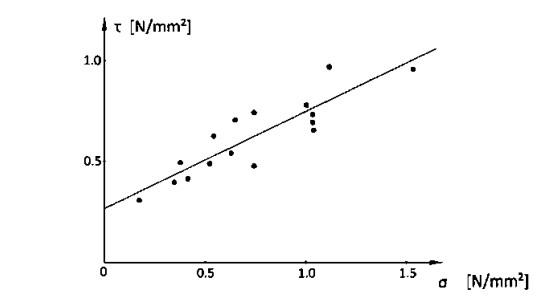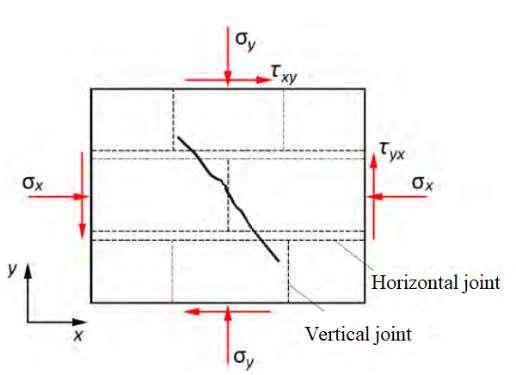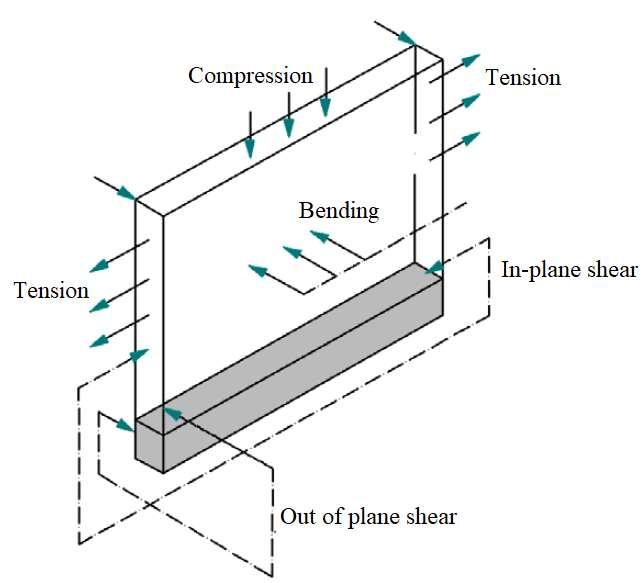
13 minute read
2.3. Masonry building structural components
In Durres city, structures with masonry walls and concrete floor slabs did not sustain significant nonstructural or structural damage. However, structures of this type experienced severe structural damage in Thumane, including partial collapse, resulting in numerous fatalities. 2.3. Masonry building structural components
Masonry is a type of composites material for construction that consists of masonry units, mortar, concrete infill and/or concrete, and reinforcing steel. A vast variety of raw materials, both natural and synthetic, are utilized in the manufacture of masonry units, both traditionally and industrially. Mortar is made out of various amounts of lime, cement, and sand that are combined with water, either with or without additions. To strengthen the masonry, deformed and smooth reinforced steel bars of different shape and qualities are inserted in mortar or grouted into holes. While each element of a masonry has its own distinct mechanical properties, whenever exposed to permanent and temporary loads, they are meant to work cohesively as an unified structural material. Naturally, not all materials are met simultaneously. Masonry construction techniques are further classified based on the materials used and/or the way they are combined in a structure: • Unreinforced (plain) masonry, which consists of mortar and masonry units. • Confined masonry is made up of masonry units, mortar, reinforcing steel, and concrete; • Reinforced masonry is made up of masonry units, mortar, reinforcing steel, and concrete infill. Due to the unique features of each constituent masonry material, particularly masonry units, it is difficult to forecast the mechanical characteristics of a particular masonry construction type using simply the constituent materials' characteristics, mortar and masonry units. It is vital, therefore, to undertake studies correlating the strength characteristics of constituent materials to the masonry properties for each type of brickwork. Due to its complexity, masonry and its constituent materials must adhere to certain standards and norms, much more so when employed in the building of engineered structures, where the resistance of individual elements and the entire structure to gravity and seismic loads is calculated. If the mechanical properties of the constituent materials and masonry as a structural material do not conform to the numerical verification assumptions, incorrect results may be drawn. Eurocode 6: “Design of masonry structures” (EC6-1, 2008) specifies the fundamental requirements for masonry materials and construction methods. Eurocode 8: “Design standards for earthquake resistance of structures” (EC8-1, 2004) specifies that iearthquake regions, additional standards for masonry materials and construction techniques must be considered. The Eurocodes are complemented by a collection of European standards that define the essential properties of masonry materials and their testing methods. Masonry Materials Design of masonry buildings against earthquakes Masonry is a special building material and requires a convenient structural configuration. Structural simplicity and regularity (figure 2-11) not only improve the expected behavior of structures, but also enable the simplification of calculation methods and ways of verification of resistance in seismic situation.
Advertisement
Figure 2-11 Examples of buildings with regular masonry in plan (Source: Tomazevic,1999)
In order to avoid the effects of torsion in the case of tall“buildings, it is recommended that the”length of the”building should be limited to four times the width.”If a longer length is needed”then the building should be divided”by joints. Division of large buildings into several part is made in order to obtain structural symmetry and simplicity. To avoid collision of the components of the building
55
with each other during the earthquake joint should have a minimum distance, obtained from the calculations.
Physico-mechanical properties of masonry During the verification of the”bearing capacity”of the masonry under the action of vertical loads and horizontal, rather than the”characteristics of the composite materials are”needed characteristics of masonry as a composite material. EN 1996-1-1 (CEN, 2005) requires the definition of the following mechanical characteristics relying on standard testing methods, described in”EN 1052-1 to 5 (EN 1052-1, 1998), (EN 1052-2, 1999), (EN 1052-3, 2002), (EN 1052-4, 2000)”and (EN 1052-5, 2005)): • compression strength fk • shear strength fv • bending strength fx • relation σ-ε (strain - deformation) In addition to the above characteristics during various structural calculations and analyzes it is necessary to know other very important features such as.”tensile strength ft, modulus of elasticity E, shear modulus G”etc.
Compression strength The characteristic resistance in compression of masonry (fk)”is influenced by the”properties of its components (i.e., by the properties of mortar and masonry units). Laboratory tests for the determination of fk should be in accordance with EN-1052-1.
The results of the tests are expressed in tabular form or described through the following equation given in EN 1996-1 (EC6-1, 2008). fk = � ∗ � ∗ � [N/mm2] Eq 2.1
In the above equation, K is a constant in units of “N/mm2” depending on the type of masonry, which should be modified as the recommendations given in Eurocode 6. The sizes fb and fm are respectively the normalized average resistance of a”masonry unit and compressive strength of masonry mortar.”The coefficients α and β are constants. Another way for determining the characteristic”compressive strength of masonry”is through the following equation for masonry with ordinary mortar, with joints completely of filled with mortar. fk = � ∗ � . ∗ � . [N/mm2] Eq 2.2
However, the use of equation (2.2) requires that certain conditions be met, e.g., detail of masonry according to Section 8 of EN 1996-1-1, fb value is limited at 75 N/mm2, fm is limit at 20 N/mm2 and the thickness of the masonry element should not be greater than the width or the length of the masonry units. Also, the coefficient of variation of the resistance of the units of masonry should not be greater than 25%. The values of K are given in Table 3.3 of EN 1996-1-1, in which is shown that for clay bricks and ordinary mortar, K takes values from 0.35 to 0.55. For the walls with thickness greater than the largest brick size, K decreases by multiplying by 0.8. In Eurocode 6, the bricks used in Albania for the structural walls of buildings can be classified in "Group 1" in terms of geometric features (because they are solid). Then, for ordinary mortar, equation (2.2) is converted to: fk = � ∗ � . ∗ � . [N/mm2] Eq 2.3
Determination of the value of compressive strength in KTP-9-78 (Ministry of Construction, 1978) is done also in function of the resistance of the mortar and the masonry units ("mortar class" and “brick class”). Design value of compressive strength for brick masonry (common, lightweight or silicate) with a wall height of up to 12cm is given in table 2-4.
56
”Nr. ” ”Brick class” ”Mortar class N/mm2”
”N/mm2” 10.0 7.5 5.0 2.5 1.5 0.4 0.0 1 15 2.2 2.0 1.8 1.5 1.35 1.2 0.8 2 10 1.8 1.7 1.5 1.35 1.1 0.9 0.6 3 7.5 1.5 1.4 1.3 1.1 0.9 0.7 0.5 4 5.0 - 1.1 1.0 0.9 0.75 0.6 0.35
In the values of the above table, the thickness of the horizontal joint is accepted 15mm while that of the vertical joint is 10mm. The wall homogenization coefficient included in the calculation of the design resistance, when in compression, is taken as 0.5, while in tension, in tension with bending or shear, is taken 0.45 (Ministry of Construction, 1978).
Tensile strength Tensile strength has a significant impact on the loss of masonry bearing capacity. Numerous researches have been carried out to correctly assess the”tensile strength of the unreinforced”masonry. For example, Backes (Backes, 1985) tested several masonry samples under the tensile forces and studied tensile failure, observing the contribution of mortar and masonry units. The author found that the resistance of masonry to tension, varied between the values 0.09 N/mm2 to 0.82 N/mm2 as a function of tensile strength of mortar and masonry unit.
Modulus of elasticity and strain-deformation relationship Modulus of elasticity In the literature equations are given to calculate the masonry modulus of elasticity E (Kornbak, 2000). In the absence of laboratory tests”according to standard EN 1052-1, E can be calculated as a function of compressive strength of masonry”(fk) through equation 2.4: E = X fk [N/mm2] Eq 2.4
where X is a factor which takes values from”500 to 1000 depending on the type of mortar and brick used in”masonry. In KTP-9-78, the X factor is labeled "elastic masonry coefficient" and is marked with the symbol α. In Eurocode 6 (EC6-1, 2008) it is advised the value of 1000 N/mm2 for service limit states, while for calculations in ultimate limit states” (mainly in nonlinear analysis) it is recommended to use the value”600 N/mm2. Based on numerous comparisons to experimental findings (Tomazevic, 1999) , it is concluded that the Eurocode recommendations result in an overvaluation of the young's modulus. Authors Thomas Zimmermann (Zimmermann & Strauss, 2012) recommends the following equation (2.5) as the most appropriate and closer to the experimental values. E = 300 fk [N/mm2] Eq 2.5
In KTP-78 (Ministry of Construction, 1978) similar values are recommended but they are also given in function of the elements of masonry and type of masonry. The KTP table is shown below (table 2-5) preserving the original units.
57
Nr. Masonry type Elastic masonry coefficient α for different mortar class 100-50 kg/cm2 25 kg/cm2 4 kg/cm2 0 kg/cm2
1 Brick masonry, concrete blocks and stone (unit weight up to 1800 kg/m3) ”1000” ”750” ”500” ”350”
2 ”Brick masonry with vertical holes” ”2000” ”1500” ”1000” -
3 ”Brick masonry with horizontal holes” ”1500” ”1000” ”750” -
4 Brick masonry, concrete blocks (unit weight over 1800 kg/m3) 2000 1000 750 -
Shear strength and shear module The shear strength of masonry combined”with tensile is one of the most important parameters in determining the lateral force that the structure is able to”withstand. The shear strength of unreinforced masonry is affected by three parameters, strength of mortar, vertical load (in compression) σv and ratio between wall height and length (size of the element). Numerous tests (Jukes & Riddington, 1997) have revealed a "Coulomb" type relationship between shear strength and compressive load applied. According to this relationship, masonry exhibits an initial shear strength which depends on the adhesion between the mortar and the brick. To this initial resistance is added a proportional coefficient (Hendry, Sinha, & Davies, 2004) to the vertical stresses to give the value of shear strength (figure 2-12). τ = τ0 + μ σc Eq 2.6
In the above equation: τ0 - shear strength when compression is zero; μ - coefficient of "friction"; σc - vertical strain in compression.

Figure 2-12 Graphical presentation of experimental results and their approximation with a linear equation (Source: Hendry,2004) In EN 1996-1-1 (EC6-1, 2008) the calculation of the shear modulus G is recommended in function of the modulus of elasticity E. Specifically: G 0.4E Eq 2.7
58
Loss of bearing capacity in shear The shear strength of masonry is defined as its resistance to lateral loads. In modeling the loss of ability of a masonry element as a result of shear forces, should considered be two possibilities (Baballeku, 2014): - sliding (figure 2-13); - crack, according to the direction of the main tensile stresses (figure 2-14). These are exactly the two main mechanisms that control the resistance of masonry to lateral loads. To assess the capacity in shear of a structural wall, considering only sliding mechanism, the value of the masonry characteristic strength to shear (fvk) is multiplied by the masonry area that provides resistance against this action.

Figure 2-13 Capacity in shear from sliding mechanism (Source: Baballeku, 2014) Meanwhile, in various works (Turnšek & F, 1971) explains the mechanism of diagonal cracks, according to which, the resistance of the wall to shear forces is determined by the tension according to the direction of the main stresses. The plane of tensile strength causes cracks according to the angle of the main stresses plane (figure 2-14).

Figure 2-14 Mechanism of diagonal cracks (Source: Baballeku,2014)
Risks affecting the safety of masonry buildings Damages due to their age (deterioration of materials) Masonry structures can be degraded according to mechanisms (Guri, 2016) which can be categorized: Chemical / biological degradation in both mortar and brick components by the action of waters containing acid, sulfate, pollutant and chemical substances emitted by plants. Corrosion of metal components in masonry (usually steel), especially ties, straps, reinforcing bars, etc. - A special case is chemical degradation. Erosion of bricks or mortar by particles derived from water and wind, frost and degradations from salt. Effects of stresses related to: foundation movements, consolidation of soil, overloads, movement from moisture of bricks, thermal movement, movement by plant growth. Bleaching due to mold and the spread of microorganisms.
Damage due to the foundation The foundation is the most vital part of the structure. Even in cases where the structures are well designed, can be damaged due to foundation problem. Problem that may be very difficult to repair, has difficulty in implementation and high costs. To determine if a foundation can survive the horizontal forces conveyed to it, it is required to evaluate its type, material, and embedding. 59
Weakening of the foundation There are two concerns about foundation damage: Degradation and cracking (Guri, 2016). a. Degradation: Degradation of the foundation is an inevitable phenomenon, which comes as a result of the action of environmental factors. By inspecting the foundation, it can be verified if there are cracks or erosion, then give repair recommendations. b. Foundation cracks: Cracking is a common occurrence when foundations are constructed with insufficient proportions. Cracks that are broader in the upper section than in the lower section are frequently produced by soil settling. For cracking that is wider at the bottom than at the top, the issue is not with the earth, but with the foundation bending.
Damage due to static and seismic loads The process of designing masonry walls requires consideration of several modes of destruction as well as limit states (CNR-DT 200, 2004; CNRDT 200 R1 / 2013) (NATIONAL RESEARCH COUNCIL, 2014). Static and seismic loads operate on masonry structures during the construction and operational phase, which may act in and out of the plane of the wall (figure 2-15). Masonry is not an isotropic material and consequently has different mechanisms of destruction under the action of loads. Masonry is resistant to the forces in compression and very weak in shear, tension and bending. Structures with masonry the have high requirements for tensile or flexural strength, should be reinforced by adding steel bars or other elements with high tensile strength.

Figure 2-15 Static and seismic loads operate on masonry structures (Source: Guri,2016) Buildings designed before the 1980s did not have antiseismic columns. It has been nearly 50 years since their construction and operation, and this period of time has surely impacted the masonry's decay and decreased its bearing capability. This degradation is also dependent on the occupants' activity. who may have harmfully affected, by intervening in the structural elements such as: in the construction of additional floors, balconies, interventions in the foundations of the building, cracks in the walls on the first floors, construction of new adjacent buildings to the existing building etc. (Guri, 2016). As a result of this interventions, they have increased their static loads in the structure, the masonry calculation scheme has changed, and some of the structural elements are overstressed.
Collapse of the wall in its plan due to seismic loads The in-plane resistance of the wall with unreinforced masonry is based on the resistance of mortar and brick. If the acting force has a value greater than the shear capacity of the masonry then the masonry will be damaged (figure 2-16). Usually, the damages in this case are cracks with an angle of 45 degrees caused by major stresses.
60










